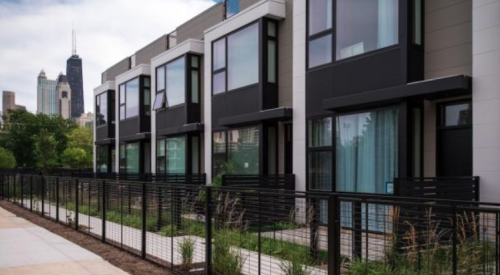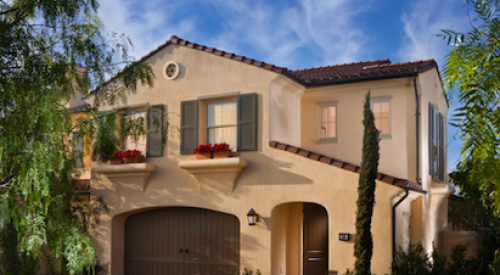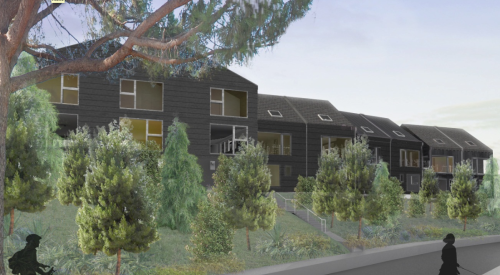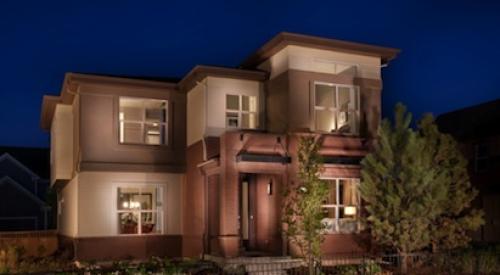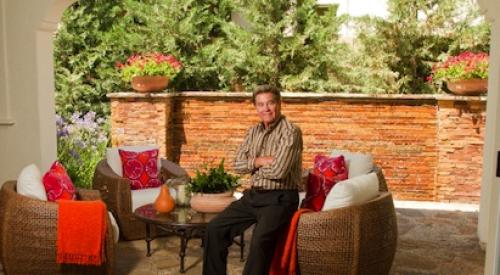| Situated on a 7-acre parcel sandwiched between Pacific Coast Highway and MacArthur Boulevard in Corona del Mar, Sailhouse marries the best of the old city architecture with the finer features of modern-day beach towns. |
Sailhouse is not a story about traditional neighborhood development and New Urbanism, even though this recently opened neighborhood in Corona del Mar, Calif., has been touted as such. “Sailhouse is a great example of product design that responds very specifically to the site, the personality of the surrounding town, the upper-end buyer and our need for optimal density,” says Dan Nahabedian, director of product development for Sailhouse builder John Laing Homes. “Now people are visiting and looking at the pedestrian focus and the alleys and labeling it TND, but that was not our goal.”
Sailhouse architect Mark Scheurer agrees. “The old beach homes of Crystal Cove here in Orange County were our inspiration,” he says. “Then we looked for modern-day beach towns that work well, and notable examples emerged from Florida’s Panhandle — Rosemary Beach and Seaside chief among them. From those points, we sought the right solutions for this site and these buyers.”
Thus, what Sailhouse exemplifies is intelligent ways to meet the planning, design and marketing issues of most infill parcels: complicated entitlements, challenging site characteristics, particular buyers and pricing that can offset high costs. And while Sailhouse presents some TND elements, it is more a case study for the rewards of the painstaking pursuit of excellence and the commitment to buyers and community.
|
“This parcel represented a once-in-a-lifetime opportunity,” says Larry Webb, CEO of John Laing Homes. “We wanted to create something that would be part of Corona del Mar from the start, something that would look like it’s been here for at least 50 years, something that will be holding its value 50 years from now.”
Laudable goals for any parcel of land, these objectives are especially critical when buyers are affluent and expecting something special. Thanks to cohesive team dynamics, sound market knowledge and a fusion of some of the industry’s top performers, Sailhouse appears to be a winner on every count. In a less-than-hot market, 22 of 27 homes released have sold, at premium prices for the high-density format (base prices of the attached homes are from $568,990, and detached are up to $794,990), to a diverse array of buyers. So what did the team do? And how?
The concept
Sailhouse is situated on a bit more than 7 net acres sandwiched between Pacific Coast Highway and MacArthur Boulevard in Corona del Mar, a tiny beach community at the tip of Newport Beach. Zoning allowed for up to 140 units, and a 40-year-old rental complex occupied the site with some 120 apartments. Above was a detached enclave, circa 1970s, that overlooked the overgrown landscaping of the apartment complex.
Laing invited competitive architectural proposals without a preconceived idea for how to handle the site, and Scheurer was an easy choice, Nahabedian says. “This is his back yard, which makes him more knowledgeable and more passionate about what needed to happen here. He also has a tremendous track record for this market area, with projects like Castaways and One Ford Road.”
Scheurer began with the desire for something contextually appropriate to the width, size and scale of Corona del Mar’s older homes. Most keep the garages in back, sit on 25- to 30-foot-wide lots and rarely top two stories. “We started with a goal of as many units as possible, consistent with this concept,” Scheurer says. “We thought 90 was a good unit count. It allowed for better square footages and more detached homes in the mix.
“If we had elected to try for-sale units at the allowable total, we would have been looking at stacked flats with underground parking and probably an average of three stories for the building forms. This was not compatible with the surroundings, and we would have run into some strong opposition from the neighbors. So we looked for ways to make the economics work, with concepts that fit with Corona del Mar’s historic character.”
Site-sensitive
That character is defined by street-facing architecture, with garages in alleys, on narrow lots. Sailhouse is adjacent to Goldenrod, one of the “flower streets,” or simply “the flowers,” a local designation for a series of streets with prototypical Corona del Mar housing and names such as Magnolia, Carnation and Poppy. The town is loaded with walkable areas for people who want to stroll, sip coffee, eat on the run or dine at leisure, shop, do errands, enjoy the theater or book it to the beach.
Scheurer says Corona del Mar itself is thus the example of TND, with Sailhouse merely fitting into an established setting. “Everything Sailhouse is missing in the classic definition of TND, Corona del Mar has,” he says. “It’s close to a major arterial, Pacific Coast Highway. It has a mix of retail shopping, including proximity to Fashion Island. It offers a variety of building types. It’s walkable, with streets that go straight to the amenities of a central commercial spine, without strip development. We saw Sailhouse as a new component that fits into a historically great town.”
Ideally situated as this new component, Sailhouse is only one block from the intersection of Goldenrod and PCH. A signal crossing offers safe passage for pedestrians aiming for village destinations. “From anywhere on our site, you can walk to the corner of PCH and Goldenrod,” Nahabedian says. “We turned the fronts of a big chunk of this project toward the street to emphasize the focus on pedestrian lifestyle. Some would apply the neo-traditional label because of that, but that was not our aim.”
Webb says the need for a pedestrian-friendly neighborhood was also driven by diverse local sources. That included research with the best-selling brokers in Corona del Mar, intensive tours of the area’s old and new housing, random conversations with locals, focus groups and architectural studies. “We put a lot of effort into trying to understand the soul of this community,” says Webb. “That soul is small-town, casual and walkable.”
Start to Finish
Converting concept to reality took some five years, with complex entitlements and a case-by-case eviction of the tenants of existing apartments. Laing further delayed the eviction process to allow families with children to finish the school year. And while purchase and entitlements added to costs and complexity, Laing gained the luxury of time, Nahabedian says. “We had the time to really examine our market, our buyer and the community. That knowledge enabled us to create the designs you see at Sailhouse, and we think the response validates the approach.”
| An internal paseo system of raised boardwalks at Sailhouse encourages foot traffic in the neighborhood or into Corona del Mar. |
The Sailhouse site plan knits itself into the Corona del Mar framework with an internal paseo system of boardwalks that encourage foot traffic within the neighborhood or into Corona del Mar. Separated and some 8 feet above street level, the paseo system is part of the attempt to make public space as pleasing as possible and easily negotiated without encroachment from cars. As described by Morris Newman in California Planning & Development Report, the paseos act as a linear courtyard, enriching the compact, gated front yard of each home, with residents able to expand their party spaces just by opening the gates.
The density tops 12 to the acre, with a combination of triplex and detached buildings in square footages of 1,367 to 2,383 — relatively modest by luxury pricing standards. The Bungalows are triplex units that line the curving, east-west perimeter street. Well-scaled, detailed architecture gives the look of detached homes. Garages sit behind the homes, and principal rooms receive maximum light. Three plans, including a carriage unit, offer 1,367 to 2,334 square feet of living space, with one- and two-car garages, two to three baths and up to three bedrooms. A pathway at every third triplex building connects these homes to interior circulation points.
Behind and above the triplex units are The Cottages, small-lot detached homes on short streets aligned with existing, surrounding residential streets. The two-story designs sit above two-car garages in tuck-under format. “Some passersby thought we were building townhomes,” Nahabedian says. “Now that we’re open, visitors can see that the boardwalk concept allows complete separation of foot traffic from the automobile, and this combines with our alley system to fully support the pedestrian focus that defines Corona del Mar.”
The Cottages provide 1,818 to 2,383 square feet of living space, with two to three bedrooms and 21/2 baths. An expanded master bedroom and a study are among layout choices. Large laundry and service areas on the garage level add convenience. “These are great spaces for stowing bicycles and beach gear, and cleaning up before coming upstairs to the living spaces,” says Lorry Zaffina, home counselor for Sailhouse. “It’s akin to the mud rooms in other parts of the country.”
The staggered levels of living above and garages below for The Cottages preserve views from second-floor spaces over The Bungalows. “We were able to take up some grade with this concept,” Scheurer says. “That was important because the site falls about 41 feet in total.”
| In the homes at Sailhouse, exposed beams and trusses appear in such unexpected places as the kitchen and master suite. |
The triplexes and the detached homes share architectural landmarks that help identify key pedestrian intersections on the site. These include seating and gathering areas, lookout decks and trellises, enhanced by benches, awnings and fireplaces. Adding interest to the high-density format, the landmarks also define circulation through the community, Scheurer says.
The homes are warm and enveloping, with well-proportioned rooms, an abundance of light, and spaces that offer ease of use, comfort and convenience. Those seeking architectural drama might be disappointed, but for those who see the best life as cozy and casual, the Sailhouse designs are ideal.
Exposed beams and trusses appear in such unexpected places as the master suites and kitchens. Some fireplaces feed two rooms. Woodwork throughout offers the refinement of much older homes. Luxury abounds in an understated way, with civility more the focus than excitement. “We’ve been labeled the warm and fuzzy architects,” says Scheurer. “We’re fine with that.”
Exterior architecture is orderly and finely detailed, combining stucco and siding that recalls Florida’s colonial past. Identifying elements include narrow gathered windows and a stucco/siding combination that reflects the two-tiered building history of St. Augustine. “The Spanish came first and built stucco homes, and then the British stacked siding-wrapped levels above,” Scheurer says. “Today, the rationale puts stucco below because of its low maintenance, with the detailed siding above growing more prominent as the landscaping matures.”
Colors also responded to historical precedent. Selected and coordinated by Miriam Tate Co., the palette was inspired by the studies of architectural teams that visited Rosemary Beach and Seaside. Returning, they handed Tate a raft of information and some 75 photos. “One thing we were very sure of was that we wanted very much not to be too nautical or Cape Cod,” Scheurer says. “This translated as no pastels, no white trim. We wanted distinction.”
Tate took it from there, with the goal of capturing the eclecticism that she says defines Corona del Mar. “Corona del Mar is such a complex, interesting, vital place, with the mix of everything that makes life interesting,” she says. “It’s full of independent thinkers who want to be intellectually and artistically stimulated. We wanted to do a proper extension of this mind-set.”
Sand, water and sunset colors influenced the resulting palette, says Jim Kerins, project manager and vice president for Miriam Tate Co. The architecture’s colonial context mandated rich, full-bodied hues for the wood-sided wall planes, with a variety of base colors that include custards, Navajo, shell and bright whites. “We play on the values of 25 color families, cross- referencing so that you see that play as the street scenes evolve,” he says. “We also added colors to the window forms, which was fun and useful in adding animation to the planes of the first floors. No two houses will be alike. To the extent that we can build a production environment and treat it with this level of individuality, we’ve been successful.”
Tate adds: “I see a wonderful happiness quotient in the colors here. Sailhouse offers architectural charm that supports the energy and diversity you see in Corona del Mar. We believe in the power of color to affect your emotions, and we think the power here is one of playfulness and joy. Mark’s architectural lead was enlightened and fabulous, and we responded to that with a color design that is deliberately avant-garde and unexpected.”
Tate’s color treatments extended to a lengthy retaining wall that restores the slope below the old Harborview homes; 25 feet at its highest point, it is of reinforced concrete with tieback rods. New, it is stained in light earthen hues. Over time, it will be covered with the greenery being established by Collaborative West landscape architects, ensuring an established patina even here.
Critics will no doubt object to such definitive theming in a town such as Corona del Mar, but Nahabedian says Laing is happy to create a distinctive look. “We wanted to pay homage to the context of Corona del Mar, and we think the architecture and pedestrian focus of the site plan does this very well,” he says. “At the same time, we did not want the pale grays, blues and brick of old Corona del Mar. We could have pulled that off, but we were searching for something fresh.”
| Homes at Sailhouse are warm and enveloping, with well- proportioned rooms and an abundance of natural light. |
An enriched spec level adds to the upscale presentation. Standard features include slab granite for kitchen countertops, antique nickel hardware, granite face and hearth for the fireplaces (both wood-burning and non-wood-burning are included per plan), oversize casing and molding, and five-burner gas cooktops, plus microwave/thermal-convection oven combinations. Less showy, equally thoughtful touches include closet storage systems, Category 5 pre-wiring, laundry sinks and recycling drawers.
While a few buyers have gone for lavish upgrading, most do not, says Donna Morrow, home counselor for Laing. “We have one buyer who spent about $150,000 on options. For most, the included features and finishes are very satisfactory.”
Quality and detailing were paramount to successful marketing, says Marianne Browne, vice president of sales and marketing for John Laing Homes. “Our buyers have money, but they have no need to show it. They are independent, secure in their tastes and seeking value. For them, quality and attention to the details of living translate to value, not extravagant design and splashy options.”
The quality quotient is also part of the trade that buyers are making in return for surrendering a piece of their individuality. Condominium ownership includes the constraints of Covenants, Codes and Restrictions, and an association. “The houses had to be great,” Nahabedian says.
Neither walled nor gated, Sailhouse also omits the customary private recreation center. “The immediate surroundings offer Starbucks for breakfast, terrific places for evening wine, for shopping and for fun at the beach,” Browne says. “A rec center was totally unnecessary.”
Scheurer agrees, adding that he does not consider Sailhouse a shining achievement as a stand-alone project. “Its contextual relationship to Corona del Mar is what shines,” he says. “Academic founders of New Urbanism are aspiring to create whole new towns, but smaller projects with some of the qualities of New Urbanism are more typical. Our job is to get as much of the philosophy of New Urbanism into smaller, infill locations like this one. Few of us will have the opportunity to create a new town, so our goal is to create great projects that deal with reality.”
